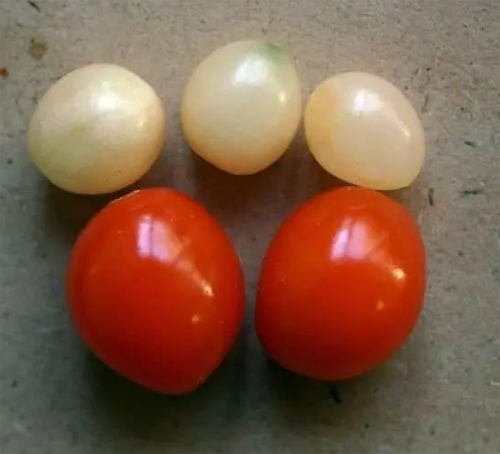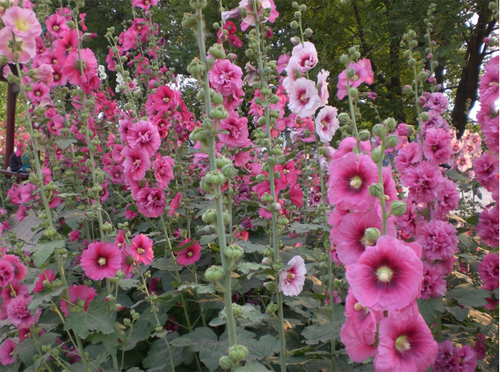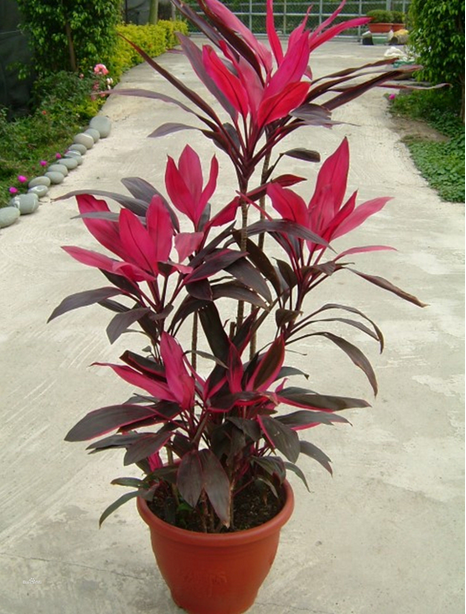What is the breeding method and breeding alias of Cymbidium
Tiger orchid is a charming leprechaun, the flowers look good, the fruit looks like a small tomato, how can there be such a lovely plant, how to raise tiger orchid? How to breed, what's the alias?

The culture method of tiger orchid:
Tiger orchid originated in South Africa, it likes the warm, humid semi-shady environment, like slightly acidic sandy loam or peat soil.
The disadvantage is that cold tolerance is poor, shade in summer, or direct semi-shade, winter overwintering temperature should not be lower than 5 ℃, after all, not cold-resistant.
1. Potted soil and fertilization
Potted tiger orchid can use rotten leaf soil, peat and coarse sand mixed soil, the growth period to keep the basin soil moist, keep a little dry can not be too wet, avoid rain or basin soil water, otherwise it will cause bulb rot.
Compound fertilizer of nitrogen, phosphorus and potassium is applied every half a month in spring and autumn.
2. Dormancy
There is a short-term semi-dormant state in winter, watering should be reduced, generally put indoors, watering should be reduced as much as possible in winter.
Tiger orchid is a lovely and beautiful foliage plant, the flowers are also very beautiful, the leaves are broad and slightly curved, graceful.
Every August, the terminal Huang Rui white flower, used to put in the warm and cool balcony is good!
The method of propagation of Cymbidium:
1. Sowing and reproduction
The seeds generally mature more than 2 months after flowering, and the seeds are relatively large. When picked, they can be sowed directly in the pot, keep slightly moist, germinate after 15 days, and the seedlings take 4-5 years to bloom.
2. Ramet propagation
Its bulb grows very slowly, and it usually takes 2-3 years to grow small branches. at that time, it can be divided into plants. when changing pots in spring, the mother plant can be pulled out, and the bulbs can be broken and planted separately.
The alias of Tiger Orchid:
Glossy (whether the leaves look like the tongue of a cow, the name is really bad), it is a perennial evergreen herb of the family Amaryllidaceae, which is a far cry from the tiger tail orchid.
A picture of the tiger's orchid blooming:
The leaves of the tiger orchid are broad and fleshy and look like succulent. The inflorescence is drawn from the short stem above the bulb, showing an umbrella-shaped terminal floret, usually white, occasionally red and yellow.
This is the end of the introduction of the breeding methods and breeding methods of the tiger orchid, as well as some introductions about the tiger orchid. This plant, raised at home, is treated as a small tomato.
A detailed explanation of Paek Sul Hui's breeding methods
✿ related reading recommended ✿ green maple ✿ Benlong ✿ Eichhornia crassipes ✿ Saxifraga (◕ Saxifraga) flower bonsai, plant culture, please pay attention to the Merlot flower bonsai area! Paek Sul Hui is a perennial succulent herb native to Guatemala, Belize, Mexico and other countries in Central and South America. It is nicknamed White Silk Grass and should have a warm and moist value. Today, the editor will briefly introduce Paek Sul Hui's breeding method. Paek Sul Hui is a perennial succulent herb. Plants tufted, stems erect or slightly creeping, 15-20 cm tall, stout fleshy stems hard and straight, covered with densely white long hairs. Leaves alternate, green or brownish green, slightly fleshy, long ovate, leaves ca. 2 cm long and 1 cm wide, also covered with dense white hairs. The floret is purplish pink, born at the top of the stem. . Paek Sul Hui should have a warm, humid environment and adequate and soft sunshine, be resistant to semi-shade and drought, avoid scorching sun exposure and basin soil stagnant water. The suitable temperature for growth was 16 ~ 24 ℃. . under this condition, the plant can be maintained in a place with bright light and no direct sunlight. If the light is not enough, it will make the plant grow too long, the distance between leaves and leaves will be lengthened, and the white hairs on stems and leaves will be sparse, which will affect the ornamental; if the light is too strong, the leaves will be brown and affect their beauty. Paek Sul Hui's reproduction can be combined with changing pots to split plants. the method is to pour the dense plants out of the basin and divide them into plants. the stems with tips can also be cut in sand or vermiculite during the growing season and placed in semi-shade to keep the soil moist without stagnant water. Under the condition of 20-25 ℃, it can take root in about 2 weeks. . Paek Sul Hui keeps the basin soil moist without stagnant water during the growing period. when the air is dry, clean water can be sprayed to the plant and the surrounding ground, but water droplets can not stay on the leaf surface for a long time, otherwise it will cause leaf rot. Apply mature thin liquid fertilizer or compound fertilizer once a month, but the amount of fertilizer should not be too much, so as to avoid excessive growth of stems and leaves and make the plant shape messy. . summer high temperature can be properly shaded, and strengthen ventilation, otherwise it will cause plant rot due to muggy and humid. Keep it in a sunny place indoors in winter and control watering. 8: 10 ℃ can safely survive the winter. Due to the rapid growth of plants, it is necessary to prune and shape the over-long stems in time, and remove the yellowing and withered leaves in the lower part, so as to keep the plant shape clean and beautiful. . because the plant is covered with long hair, it is difficult to remove it after being stained with dirt, so extra care should be taken when applying fertilizer to prevent the plant from being contaminated by fertilizer liquid, and the flowerpot should be kept in a clean indoor place to avoid outdoor rain contaminating the leaves. . Conclusion: Paek Sul Hui maintenance is also relatively simple, very suitable for family cultivation and appreciation, often for small potted plants, decorated with a few cases, desks, windowsills and other places, fresh and elegant, quite distinctive. That's all for today's introduction of Paek Sul Hui breeding methods. Thank you for your appreciation. If you still want to know the characteristics of other plants, you can click on the link below for more information waiting for you. [article source] Flower bonsai
✿ flower bonsai ✿
Characteristics of ✿ peonies ✿ how to raise azaleas ✿ cactus poisonous ✿ black mandala flowers ✿ rich bamboo how to raise ✿ cactus use ✿ snow lotus fruit how to eat ✿ Cistanche what is the harm of ✿ water hyacinth ✿ Hedyotis diffusa price ✿ sweet-scented osmanthus tree characteristics ✿ golden monkey cactus ✿ perfume lily Price ✿ peony picture ✿ mimosa will blossom ✿ pink rose ✿ cyclamen how to raise ✿ remember my flower picture ✿ red carnation picture ✿ betel nut what is ✿ * * Tianshan snow lotus ✿ how to raise wealth tree ✿ thousand-hand Avalokitesvara picture ✿ rose cultivation technology ✿ rubber tree culture method ✿ Characteristics of mimosa ✿ Magnolia lanceolata pictures ✿ iron tree leaves yellowing ✿ pictures of rich bamboo in water ✿ pictures of aloe vera
What is the difference between tiger tail orchid and tiger skin orchid? what are the varieties of tiger tail orchid?
Tiger tail orchid has great changes in plant shape and leaf color, has many varieties, and has a strong ability to adapt to the environment, so it is welcomed by many friends. What's the difference between tiger tail orchid and tiger skin orchid? What are the varieties of tiger tail orchid? Let's get to know each other.
What is the difference between tiger tail orchid and tiger skin orchid
Tiger tail orchid is a common potted plant in the family, which is planted in many families, and many flower friends are asking what is the difference between tiger tail orchid and tiger skin orchid. In fact, the tiger tail orchid we are talking about is tiger skin orchid, just because there are many varieties of tiger tail orchid on the market, so there are tiger tail orchid and tiger skin orchid. Let's take a look at the varieties of Tiger Pilan.
Second, tiger tail orchid varieties
Short-leaf tiger tail orchid pictures
Short-leaf tiger tail orchid: a cultivated variety of tiger tail orchid, also known as Xiaolan tiger and tiger orchid. The plant is low and the plant height is not more than 20 cm. The leaves rotate outward from the center and overlap each other to form a bird's nest. The leaf is short and wide, long ovate, leaf tip acuminate, with obvious short tail tip, leaf length 10-15 cm, width 12-20 cm, leaf color dark green, leaf edge on both sides have a wide yellow band, leaf surface has irregular silver-gray stripes. Leaves fascicled, luxuriant.
Phnom Penh short-leaf tiger tail orchid
Phnom Penh short-leaf tiger tail orchid: the height of the leaf is also short, above 10cm, and the edge is golden yellow, strip display. Strong adaptability, warm and humid sex, drought resistance, light and shade tolerance. The requirement of soil is not strict, and the sandy loam with better drainage is better. The suitable temperature for growth is 20-30 ℃, and the overwintering temperature is 10 ℃. Cymbidium can be propagated by ramet and cuttage.
Silver-edged tiger tail orchid pictures
Silver short-leaf tiger tail orchid: alias silver short-leaf tiger tail orchid. It is a cultivated variety of Cymbidium. The plant shape and leaf shape are similar to those of Cymbidium. Leaves short, silvery white, with inconspicuous transverse markings. The height of the leaf is short, the edge of the leaf is silvery white, and the length is about 10cm.
Silver vein tiger tail orchid picture
Silver vein tiger tail orchid: the silver vein tiger tail orchid is the cultivation variety of the tiger tail orchid, the tiger tail orchid is native to western Africa. Like warm, dry and sunny environment. Not cold-resistant, semi-overcast, avoid stagnant water and waterlogging. Sandy loam with good drainage and loose is required. The leaves are irregular, the edges are silvery white, and the leaves are uneven, with wide leaves and narrow leaves. The winter temperature is not lower than 5 ℃. It is mainly propagated by individual plants. Can be combined in the spring to change the basin, the dense leaves will be removed, cut into a clump of 3-4 leaves, each clump must take a section of rhizome and sucking buds, a month after the pot can grow new leaves.
Green onion leaves tiger tail orchid pictures
Green onion tiger tail orchid: the leaf is cylindrical, the whole leaf is about the same thickness, the end is slightly pointed and thin, the leaf surface has a longitudinal shallow concave shape, each leaf grows independently. The branches are as slender as sticks and the lines are simple. Can absorb a lot of toxic gases, absorb a lot of carbon dioxide at night, and increase the concentration of negative ions. Resistant to shade, it is an ideal indoor plant.
Phnom Penh tiger tail orchid pictures
Phnom Penh tiger tail orchid: perennial herb, the rhizome is rolled into a tube-shaped, the leaves are drawn out into a tube-shaped, as the leaves gradually rise, will gradually expand life. The leaves are thick and leathery, and Phnom Penh is a perennial succulent herb. With creeping rhizome, brown, semi-lignified, strongly branched. Leaves arising from underground stems, tufted, flattened, erect, apex acute, sword-shaped; leaves 30-50 cm long and 4-6 cm wide, entire. The leaves are light green, with white and dark green horizontal stripes such as clouds on both sides, shaped like tiger skin, with a thick waxy layer on the surface.
Fan leaf tiger tail orchid pictures
Fan leaf tiger tail orchid: the edge of the leaf is striped, and the leaf is shaped like a fan. Native to tropical America, Somalia. With creeping fleshy rhizome, about 2-4 leaves per bud, fleshy long oval, 50-70 cm long, 10-15 cm wide, with light green and dark green horizontal stripes. The main feature is that the leaf edge has a reddish-brown edge.
The above is the difference between tiger tail orchid and tiger skin orchid, in fact, tiger tail orchid is tiger skin orchid, so you can choose your favorite tiger tail orchid breed.
- Prev

What is the price of seeds for propagation and pest control of hollyhock
Hollyhock used to grow in Sichuan, just have the name of hollyhock, how does hollyhock breed? If you want to raise a few more plants at home, which diseases and insect pests are easy to encounter in the process of breeding? What is the price of hollyhock seeds? Propagation method of hollyhock: sowing season, sowing after the seeds are mature in August and September
- Next

What is the breeding method and breeding alias of Zhu Jiao?
This kind of plant Zhu Jiao is quite magical. The more the leaves inside, the redder the leaves are, and the more beautiful they are. If there is a large piece of Zhu Jiao, it will be amazing. It will be half red directly. What is the breeding method of Zhu Jiao? How to reproduce?
Related
- Fuxing push coffee new agricultural production and marketing class: lack of small-scale processing plants
- Jujube rice field leisure farm deep ploughing Yilan for five years to create a space for organic food and play
- Nongyu Farm-A trial of organic papaya for brave women with advanced technology
- Four points for attention in the prevention and control of diseases and insect pests of edible fungi
- How to add nutrient solution to Edible Fungi
- Is there any good way to control edible fungus mites?
- Open Inoculation Technology of Edible Fungi
- Is there any clever way to use fertilizer for edible fungus in winter?
- What agents are used to kill the pathogens of edible fungi in the mushroom shed?
- Rapid drying of Edible Fungi

